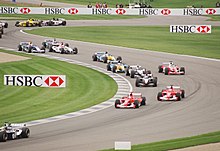Grands Prix
Six of the original seven races took place in Europe; the only non-European race that counted towards the World Championship in 1950 was the Indianapolis 500, which, due to lack of participation by F1 teams, since it required cars with different specifications from the other races, was later replaced by the United States Grand Prix. The F1 championship gradually expanded to other non-European countries as well. Argentina hosted the first South American grand prix in 1953, and Morocco hosted the first African World Championship race in 1958. Asia (Japan in 1976) and Oceania (Australia in 1985) followed. The nineteen races are spread over the continents of Europe, Asia, Oceania, North America and South America.
The Grands Prix, some of which have a history that pre-dates the Formula One World Championship, are not always held on the same circuit every year. The British Grand Prix, for example, though held every year since 1950, alternated between Brands Hatch and Silverstone from 1963 to 1986. The only other race to have been included in every season is the Italian Grand Prix. The World Championship event has taken place exclusively at Monza with just one exception: in 1980, it was held at Imola, host to the San Marino Grand Prix until 2006.
One of the newer races on the Grand Prix calendar, held in Bahrain, represents Formula One's first foray into the Middle East with a high-tech purpose-built desert track. The Bahrain Grand Prix, and other new races in China and Turkey, present new opportunities for the growth and evolution of the Formula One Grand Prix franchise while new facilities also raise the bar for other Formula One racing venues around the world. In order to make room on the schedule for the newer races, older or less successful events in Europe and the Americas have been dropped from the calendar, such as these in Argentina, Austria, Mexico, France, San Marino, and the United States.
Even more recent additions to the calendar include the Valencia Street Circuit, which became the host of the European Grand Prix in 2008, giving Spain two Grands Prix. In September 2008, the Singapore Grand Prix, hosted the first night race ever held in Formula One, in order to be held at a time better suited to the sport's core European audience. The most recent addition to the calendar is the Abu Dhabi Grand Prix, which hosted the final race of the 2009 season, becoming the first day-to-night race. New events scheduled to join the calendar in the near future include the Korean Grand Prix, which will be held for the first time in October 2010, and the Indian Grand Prix which will be held in Delhi, India in October 2011. The United States Grand Prix will be hosted in Austin, Texas from 2012–2021.
Circuits
Most of the circuits currently in use are specially constructed for competition. The current street circuits are Monaco, Melbourne, Valencia, and Singapore, although races in other urban locations come and go (Las Vegas and Detroit, for example) and proposals for such races are often discussed–most recently London and Paris. Several other circuits are also completely or partially laid out on public roads, such as Spa-Francorchamps. The glamour and history of the Monaco race are the primary reasons why the circuit is still in use, since it is thought not to meet the strict safety requirements imposed on other tracks. Three-time World champion Nelson Piquet famously described racing in Monaco as "like riding a bicycle around your living room"
Circuit design to protect the safety of drivers is becoming increasingly sophisticated, as exemplified by the new Bahrain International Circuit, added in 2004 and designed—like most of F1's new circuits—by Hermann Tilke. Several of the new circuits in F1, especially those designed by Tilke, have been criticised as lacking the "flow" of such classics as Spa-Francorchamps and Imola. His redesign of the Hockenheim circuit in Germany for example, while providing more capacity for grandstands and eliminating extremely long and dangerous straights, has been frowned upon by many who argue that part of the character of the Hockenheim circuits was the long and blinding straights into dark forest sections. These newer circuits, however, are generally agreed to meet the safety standards of modern Formula One better than the older ones.
The most recent additions to the F1 calendar are Valencia, Singapore and Abu Dhabi A Formula One Grand Prix will be held in India for the first time in 2011. Tilke is designing the India circuit while Design Cell, a reputed landscape architectural firm based in India and US are designing the landscape for all the areas.
A single race requires hotel rooms to accommodate at least 5000 visitors.




0 comments:
Post a Comment